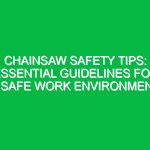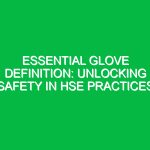Understanding Falls, Trips, and Slips in the HSE Context
Falls, trips, and slips are among the most common workplace accidents, resulting in significant injuries, lost workdays, and increased healthcare costs. In the Health, Safety, and Environment (HSE) domain, understanding these incidents is crucial for creating a safe work environment. A fall, trip, or slip can occur in any workplace setting, from construction sites to office environments, where uneven surfaces, wet floors, or clutter can pose risks. Addressing these hazards is not only a legal obligation for employers but also a moral responsibility to ensure the well-being of employees.
In 2022, the Occupational Safety and Health Administration (OSHA) reported that slips, trips, and falls accounted for approximately 27% of all workplace injuries. This statistic underscores the pressing need for employers to implement effective safety measures. Additionally, the financial implications are significant: lost productivity, medical costs, and potential legal fees can quickly add up, making prevention a priority.
Key Concepts Surrounding Falls, Trips, and Slips
Understanding the nuances of falls, trips, and slips is essential for effective prevention strategies. Below are key concepts that every workplace should consider:
The Nature of Falls, Trips, and Slips
1. **Falls**: These occur when a person descends from a height or loses balance and comes to rest on the ground or lower level. Falls can happen from ladders, stairs, or even flat surfaces if there is a loss of balance.
2. **Trips**: Tripping occurs when an individual’s foot strikes an object, causing them to lose balance. Common tripping hazards include loose cables, uneven flooring, and obstructive items in walkways.
3. **Slips**: Slipping happens when there is a loss of traction between footwear and the walking surface. Wet or oily floors are typical culprits for slips.
Common Causes of Falls, Trips, and Slips
Recognizing the common causes of these incidents can aid in prevention efforts. Here are a few prevalent factors:
- Environmental conditions: Weather-related issues, such as rain or snow, can make surfaces slippery.
- Workplace layout: Poorly designed workspaces with cluttered walkways can lead to trips.
- Inadequate training: Employees who are not trained in safety protocols may be unaware of hazards.
- Improper footwear: Shoes that do not provide adequate traction can increase the risk of slipping.
Preventive Measures for Falls, Trips, and Slips
Implementing preventive measures is crucial for reducing the risk of falls, trips, and slips. Here are essential tips for creating a safer workplace:
Conduct Regular Risk Assessments
A comprehensive risk assessment should be the foundation of any safety program. Identify potential hazards in your workplace and evaluate the likelihood of incidents occurring. Regular assessments ensure that new hazards are recognized and mitigated promptly. For instance, in a manufacturing facility, spills may occur frequently; thus, ensuring that employees are aware of proper cleaning protocols can significantly reduce risk.
Maintain Clean and Organized Workspaces
Cluttered walkways and work areas increase the risk of trips and falls. Implementing a clean-as-you-go policy can help maintain order. Encourage employees to keep their workspaces tidy and to report any hazards immediately. A real-life example comes from a busy kitchen where chefs were required to keep their stations clean. By implementing this practice, the number of slip incidents dramatically decreased.
Use Proper Signage and Markings
Clear signage is vital for alerting employees to potential hazards. Use signs to indicate wet floors, uneven surfaces, or areas under maintenance. Additionally, floor markings can help guide traffic flow and delineate safe walking paths. In a retail environment, for example, using bright yellow tape to mark areas where spills occurred can effectively alert customers and staff alike.
Enhance Lighting in Work Areas
Insufficient lighting can contribute to falls and trips. Ensure that all work areas, staircases, and hallways are well-lit. Consider using motion-sensor lights in less frequently used areas to enhance visibility. A case study from a warehouse revealed that after increasing lighting in storage areas, the incidence of falls decreased by 40%.
Implement Training Programs
Training is essential for informing employees about workplace hazards and safety practices. Regular safety training sessions should cover topics such as hazard recognition, proper lifting techniques, and the importance of wearing appropriate footwear. Incorporate practical exercises that allow employees to identify hazards in their own workspaces. A hospitality company that implemented biannual training sessions reported a 25% reduction in slip-related injuries after just one year.
Provide Proper Footwear
Encouraging or mandating the use of slip-resistant footwear can significantly reduce the risk of slips. Employers should consider providing suitable shoes for employees who work in high-risk areas. For example, a factory that required employees to wear specific types of shoes noticed a decrease in slip-and-fall incidents.
Addressing Hazards: Case Studies and Real-Life Examples
Examining real-life examples can shed light on effective strategies for preventing falls, trips, and slips.
Case Study: The Construction Site
A construction site in Texas faced an alarming number of slip-and-fall incidents due to uneven ground and scattered tools. After conducting a thorough assessment, the site manager implemented a new protocol: daily inspections for hazards, mandatory safety gear, and designated tool drop zones. Within six months, the site reported a 60% reduction in slip-and-fall accidents.
Case Study: The Office Environment
In a corporate office, employees frequently complained about slipping on wet floors during rainy weather. Management decided to install mats at the entrance and increase the frequency of floor cleaning during wet days. They also organized a safety meeting to remind employees about the importance of reporting spills immediately. These measures resulted in a significant decline in slip incidents.
Regulations and Standards Surrounding Falls, Trips, and Slips
Understanding the regulatory framework surrounding falls, trips, and slips is essential for compliance and safety. OSHA sets forth regulations that require employers to maintain a safe working environment. Some key regulations include:
- OSHA Standard 1910.22: This standard mandates that walking-working surfaces must be kept clean and orderly.
- OSHA Standard 1910.23: This regulation requires employers to provide guardrails for employees working at elevated heights.
- OSHA Standard 1910.28: This standard outlines requirements for fall protection in general industry settings.
Complying with these regulations not only protects employees but also helps organizations avoid potential fines and legal issues. Regular audits and safety checks can aid in maintaining compliance.
Conclusion
Falls, trips, and slips represent a significant risk in various workplace settings, demanding continuous attention and proactive measures. By understanding the nature of these incidents, recognizing common causes, and implementing effective preventive strategies, employers can create a safer work environment. Regular training, risk assessments, and adherence to regulations are vital components of a robust safety program.
Ultimately, the commitment to preventing falls, trips, and slips is an investment in the health and safety of employees. By prioritizing safety, organizations not only protect their workforce but also enhance productivity and foster a culture of care. As we move forward, let us remain vigilant and proactive in mitigating these risks, ensuring that every workplace is a safe one.


